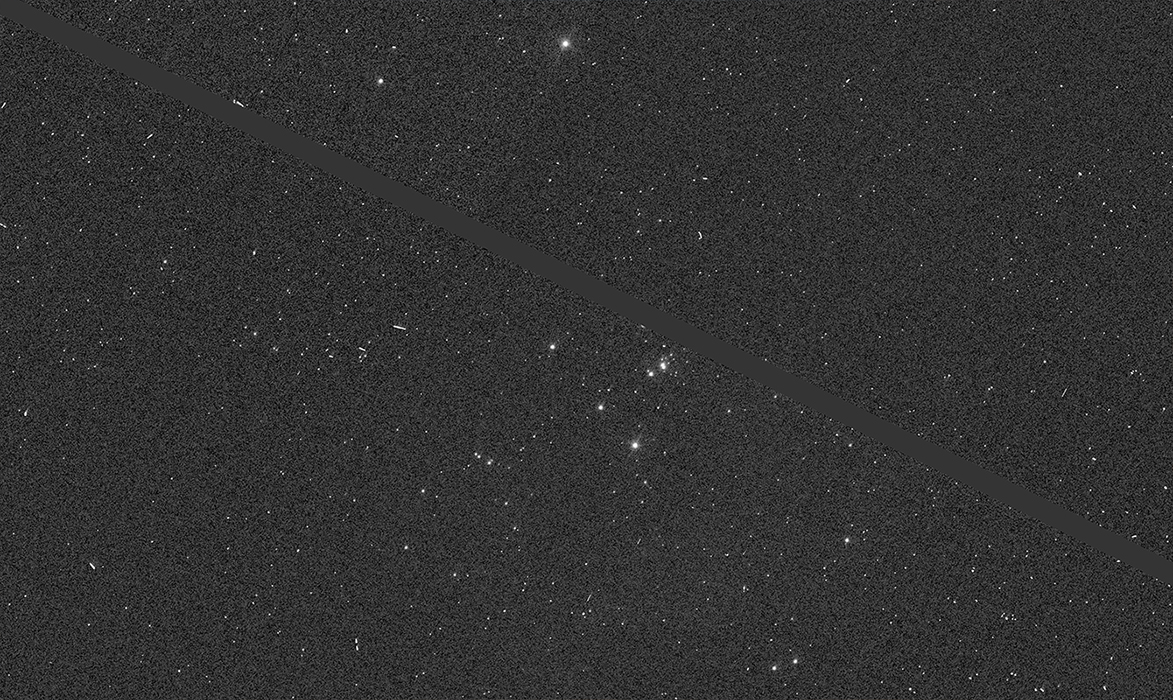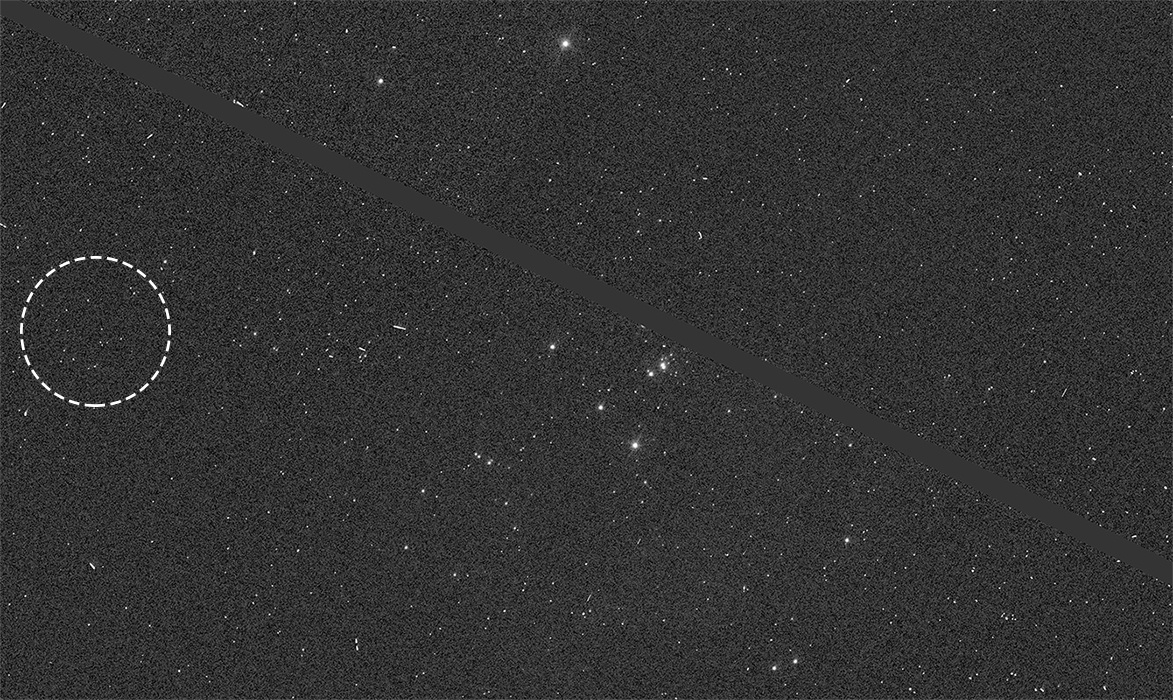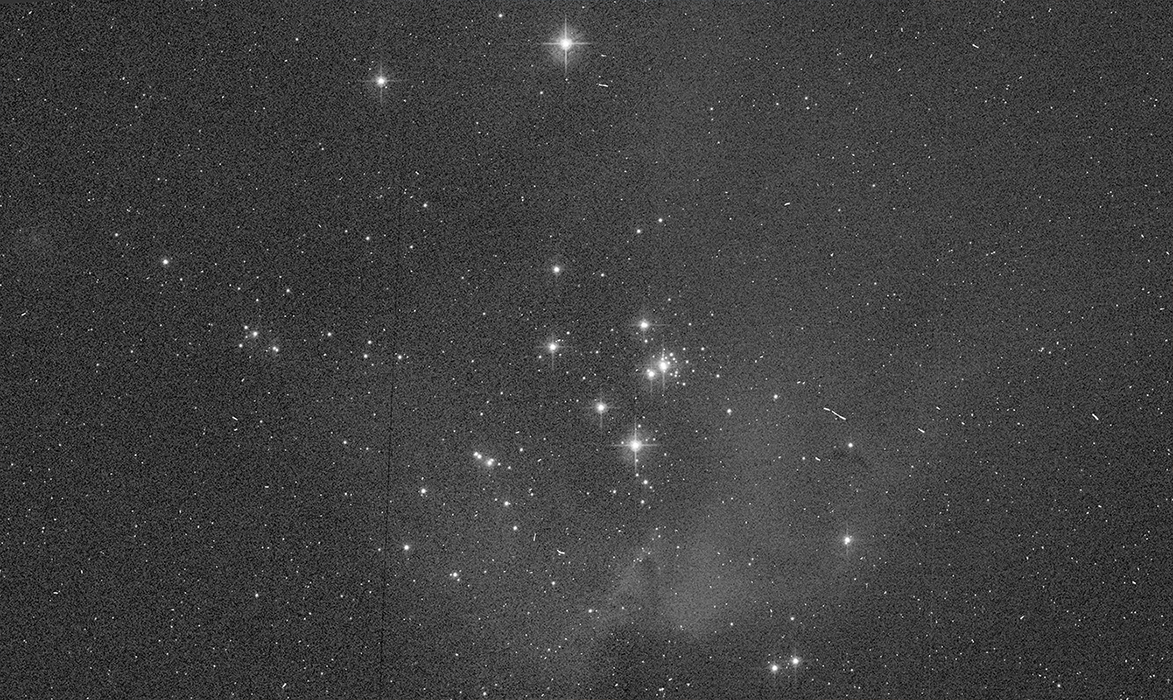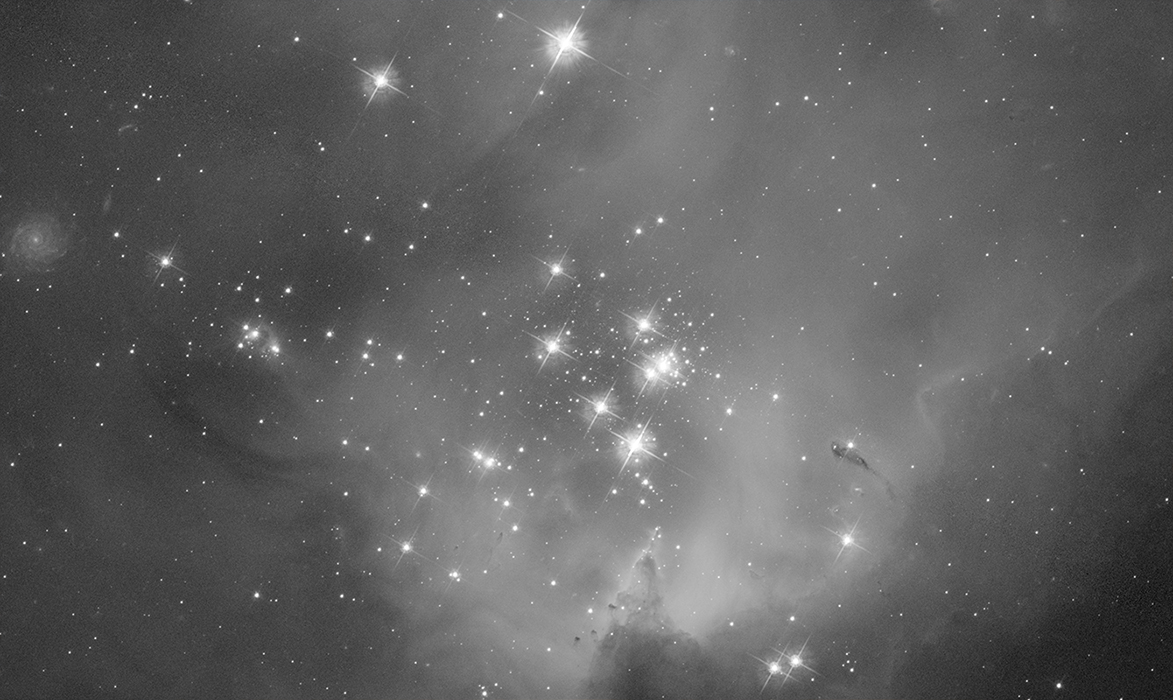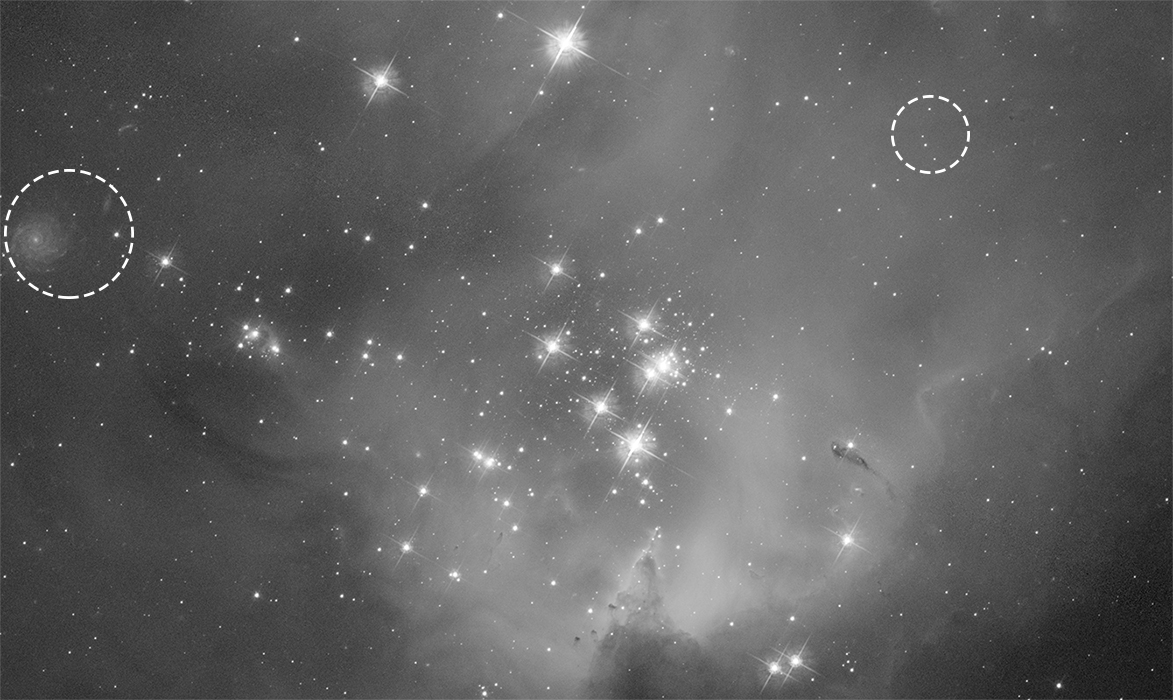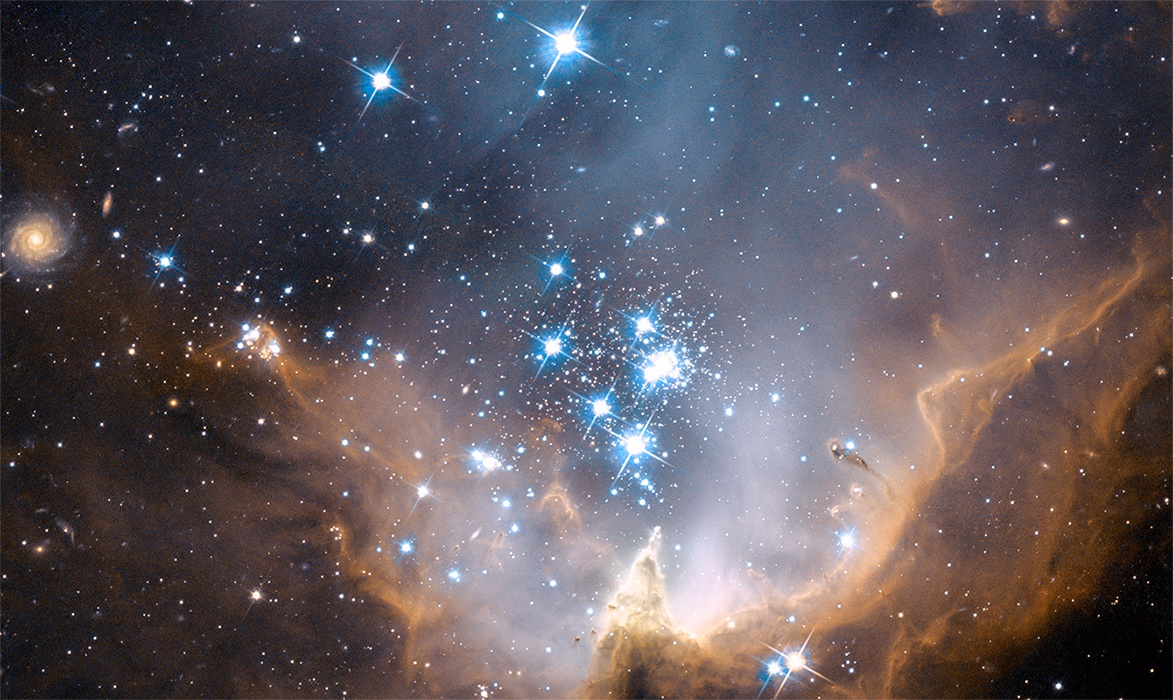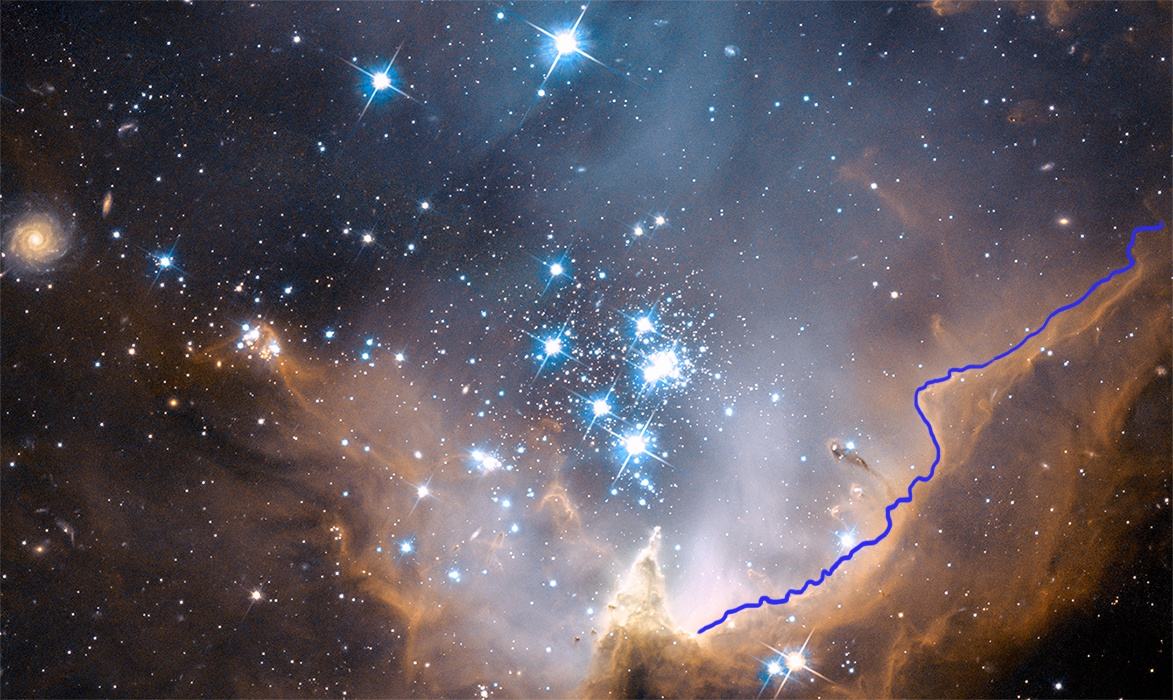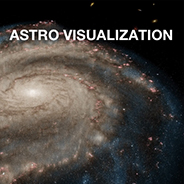Interactive Overview
Slider Interactive: A series of images showing different exposure times of the same patch of sky containing stars, dust, and galaxies. Below the caption is a horizontal slider bar with four labeled stops and a solid white circle. Dragging the white circle right and left along the slider bar causes the image, labels, and caption to change. The change occurs gradually as one image, along with its associated caption and labels, fades out and the next fades in. A toggle button to the upper right of the image turns the image labels off and on. Some labels are in the form of text with arrows pointing to specific features in the image. Other labels are graphic overlays.
Slider Stops
From left to right, the slider stops are labeled: 5 seconds, 29 seconds, 36 minutes, and Multicolor visible.
Summary of Slider Stops
Sliding left to right reveals the following:
- “5 seconds” stop shows what the swath of sky looks like after 5 seconds of exposure time with some stars on a noisy background. This is the initial image shown when the interactive is loaded.
- “29 seconds” stop shows the same swath of sky with more details including the first hints of a nebula.
- “36 minutes” stop shows the same swath of sky in great detail, including wispy dust, faint stars, and background objects.
- “Multicolor visible” stop shows a highly detailed and crisp color composite image of the same swath of sky.
Stop 1: 5 seconds
Image Description: 5 seconds
Grayscale image of a patch of sky after 5 seconds of exposure time. Small white specks are scattered across the dark sky, and a few slightly larger fuzzy objects are also visible. A cluster of small white dots, slightly brighter than the other white points of light in the image, is in the center. A thick solid gray bar cuts across the image diagonally from the upper left corner to the bottom right.
Labels: 5 seconds
There are three text labels and one graphic overlay. On the left side, a cluster of small white points in a white dashed-line circle is labeled “Visual noise.” In the center of the image, the cluster of bright points, some with diffraction spikes, is labeled “Bright stars.” The diagonal gray bar is labeled “Gap between detectors.”
Caption: 5 seconds
In this faint, five-second exposure, we can barely make out the brightest stars through the visual noise.
Stop 2: 29 seconds
Image Description: 29 seconds
This image reveals the same patch of sky after 29 seconds of exposure time and is also in grayscale. Some objects seen in the “5 seconds” stop are brighter and more accentuated, with small white spikes from the points of the central stars. Some of the white points previously seen with a shorter exposure time are now gone. Objects not previously seen in the “5 seconds” stop are now visible, including additional stars and a cloud-like haze that surrounds the central star cluster. The thick, diagonal solid gray line seen in the prior stop is no longer visible. A thin, black vertical line is in the center left.
Labels: 29 seconds
There are three text labels. The thin, black vertical line is labeled “Artifact from dead detector pixel.” In the center, a cluster of small circles with diffraction spikes is labeled “Nebula and central stars emerge.” A short, thin white line toward the right is labeled “Streak from cosmic ray hitting detector.”
Caption: 29 seconds
As exposure time increases, the stars and faint nebula begin to be revealed.
Stop 3: 36 minutes
Image Description: 36 minutes
This image reveals the same patch of sky shown after 36 minutes of exposure time. In this grayscale version, bright objects are clearly defined, additional objects are visible, and characteristics of the environment become apparent and detailed. Smoke-like wisps surround the central star cluster where bright white points with four diffraction spikes lie, which look bigger and brighter than in the previous “29 seconds” stop. Beneath the group of stars is a spire-shaped pillar of dust. Faint ridges of dust run diagonally across the image, and the cloud-like haze seen in the prior “29 seconds” stop is now even more apparent in the image overall. In the upper left, there is a faint spiral-shaped object. Some of the white points previously seen in images with shorter exposure times are now gone.
Labels: 36 minutes
There are three text labels and two graphic overlays. The spiral-shaped object is circled by a white dashed-line and labeled “Background galaxies emerge.” Below, a cluster of small fuzzy smudges with diffraction spikes is labeled “Cluster of newly formed stars.” On the right, tiny dots in a white dashed-line circle are labeled “Fainter stars appear.”
Caption: 36 minutes
With more exposure time, more features pop out.
Stop 4: Multicolor visible
Image Description: Multicolor visible
This image reveals the same patch of sky but this version is in color instead of grayscale. Orange, blue, and white objects are peppered across this dark swath of space. Light brown dust surrounds the bright blue cluster of four-pointed stars in the center. Clumps of dense dust are towards the bottom of the image, including a spire-shaped pillar of dust beneath the central star cluster. Objects with a variety of shapes and sizes are seen in this image, including: tiny points, spiral-shaped galaxies, asymmetrical streaks, and dots with diffraction spikes.
Labels: Multicolor visible
There are three text labels and one graphic overlay. The bright blue four-pointed stars in the center are labeled “Hot, young stars in central cluster.” Below, the spire-shaped pillar of light brown dust is labeled “Cocoon of newborn stars.” On the right, a wavy blue line that traces the edge of a cavity among dense dust is labeled “Dense ridge of warm dust.”
Caption: Multicolor visible
Image processing combines three, single-color images to produce a multicolor picture of this star-forming region.
